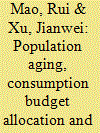|
|
|
Sort Order |
|
|
|
Items / Page
|
|
|
|
|
|
|
| Srl | Item |
| 1 |
ID:
180632


|
|
|
|
|
| Summary/Abstract |
Pandemic outbreaks disrupt agricultural trade. The possible strengthening of import
barriers to products from countries at the epicenter of a pandemic by their trade
partners could aggravate this situation. This paper examines the responses of the US
Food and Drug Administration (FDA), import refusals, and subsequent trade impacts
on the agricultural exports from the developing countries that were the epicenters of
four pandemics in the past two decades. Using monthly data for the period 2002–2020,
we fi nd increased import refusals and amplifi ed trade-impeding impacts on agricultural
exports during pandemic outbreaks. Increased import refusals and the amplifi cation of
the trade-impeding effect of import refusals were especially large when China was the
epicenter. We further examine possible differences in these results across products and
FDA inspection methods, and the main conclusions remain robust. This paper offers
a better understanding of the economic outcomes of pandemic outbreaks and provides
policy suggestions for China.
|
|
|
|
|
|
|
|
|
|
|
|
|
|
|
|
| 2 |
ID:
163326


|
|
|
|
|
| Summary/Abstract |
This paper studies the relationship between population aging and structural change in terms of employment distribution in the non-agricultural sector. Based on cross-country panel data, it is revealed that a greater share of elderly workers in the labor force is associated with more service employment relative to that in the industrial sector. To rationalize this finding, a two-sector overlapping generations model is constructed. The model highlights two forces, namely the “scale effect (SE)” and the “composition effect (CE)”, that drive the correlation between the labor force age structure and the service-industry employment ratio. Calibrating main model parameters with China's micro level data, simulation results well fit the country's historical trajectory of structural change. According to population forecast data, the model predicts a substantial growth of services relative to the industrial sector in China up to 2050.
|
|
|
|
|
|
|
|
|
|
|
|
|
|
|
|
| 3 |
ID:
140234


|
|
|
|
|
| Summary/Abstract |
Structural change theories usually assume agents are homogeneous. However, because of demand-side or supply-side heterogeneities, the probability of switching among sectors differs across people. This paper reveals these differences through restoring a long-period, individual-level panel dataset from China's Urban Household Survey for 1986–2009. We find that both for people who started working for the first time and those who switched jobs, the sector choice depends on personal characteristics. In particular, women and people with higher educational attainment or a previous white-collar job are more likely to join the tertiary sector and less likely to join the primary sector. These effects are substantial even if the macroeconomic variables used in conventional structural change theories are controlled. They are also robust in various periods and at more detailed industry levels. Our research suggests that it is important to pay greater attention to the labor composition when making policy related to economic structural change.
|
|
|
|
|
|
|
|
|
|
|
|
|
|
|
|
| 4 |
ID:
134852


|
|
|
|
|
| Summary/Abstract |
This paper assesses the heterogeneous effects of population aging on personal budget allocation across sectors. Using China's household survey data, we break down each household expenditure component into its constituent members. We find consistent and robust age profiles of the composition of personal consumption expenditures. Young people spend larger proportions of their budget on food and education, culture, and recreation services. The middle-aged spend significantly more on clothing and transportation and communication. Lastly, the elderly spend substantially more on food and health care and medical services. After controlling for period and cohort effects as well as other socio-economic factors, we still find age to be a fundamental driver of consumption budget allocation. We also incorporate the estimated results into the population forecast data and predict the evolution of China's consumption budget allocation patterns driven by demographic change.
|
|
|
|
|
|
|
|
|
|
|
|
|
|
|
|
| 5 |
ID:
168360


|
|
|
|
|
| Summary/Abstract |
This paper studies how the fixed exchange rate regime (FERR) may promote growth when a country experiences faster rates of productivity growth in its tradable sector than its nontradable sector. In a simple two-sector model with money, we show that the FERR can reduce the Balassa-Samuelson effect if wage adjustment is subject to nominal rigidities. The undervaluation thus created suppresses real wage growth but increases the size of the tradable sector and leads to higher growth rates of the entire economy. Using cross-country panel data, our econometric exercises provide robust evidence that supports the results. Meanwhile, other fundamentals, including the external balance position, export share in the tradable sector, and the stage of development, play roles in determining the effects of FERR. Last, we apply the empirical results to run simulations on China from 1994 to 2007 to highlight the role of FERR in the country's export-led growth.
|
|
|
|
|
|
|
|
|
|
|
|
|
|
|
|
|
|
|
|
|